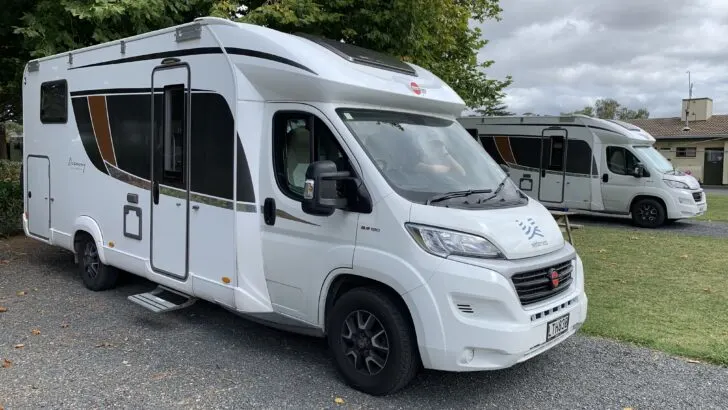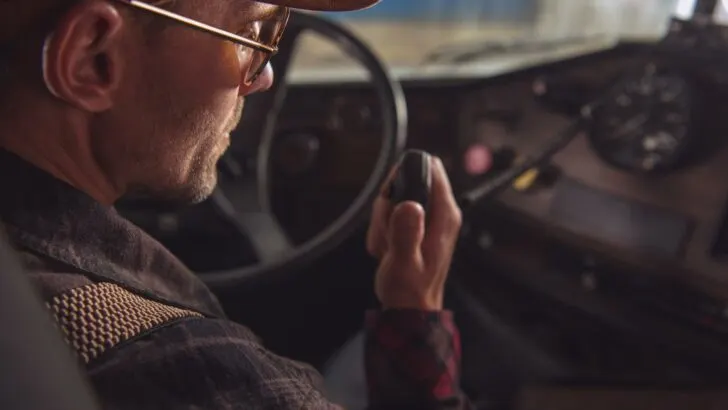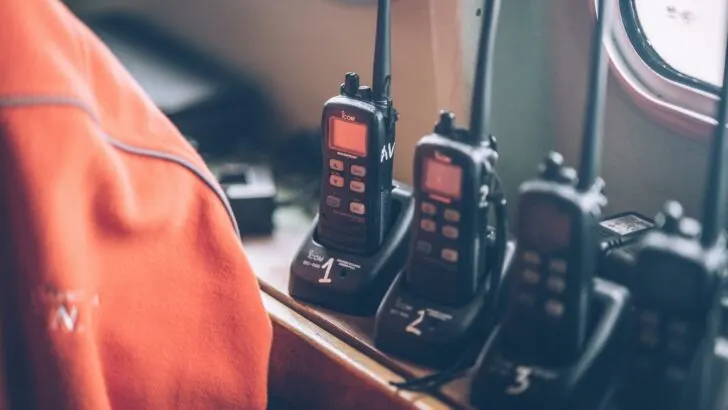Two-way radios (walkie-talkies) may just be the RVing gear you didn’t know you need … until you need them. That’s why today we’re focusing on the best walkie-talkies for RVers … because good communication can be essential to safe camping.
Why Are Walkie-Talkies Important Gear for RVers?
As many of you know, we’ve been full-time RVers for nearly 20 years, so we’ve got a pretty good handle on what gear is important and what can be tossed. And believe it or not, our two-way radios continue to come in handy to this day. Here’s why:
Backing Into a Campsite
This is the main reason RVers tend to grab a pair of walkie-talkies, (although they soon learn that there are multiple other important uses for them).
Two-way communication is extremely helpful when you’re backing an RV into a campsite or out of a driveway or parking space.
If you read our recently posted guide to backup cameras for RVs, you may have noticed that many backup cameras aren’t equipped with sound at all. Moreover, of the cameras that are equipped with audio, most only allow one-way audio, so no real communication.
While one-way sound can be helpful, there are many scenarios in which two-way communication would be best, and some cases in which it’s essential.
RV Caravan Traveling
If you’re traveling with other RVers in a caravan, two-way radios can be extremely helpful, especially where there’s no cell phone coverage.
We’re avid boondockers, and we’ve found two-way radios to be very helpful in this regard.
In fact, we recently spent 5 weeks traveling by RV in Europe with dear friends — our co-hosts on The RVers, Tom and Cait (Mortons on the Move) and Heath & Alyssa Padgett. Our walkie-talkies were exceedingly helpful as we convoyed through France, Switzerland, Italy, and Spain in our awesome Anywhere Campers motorhomes.
We’re RVed internationally with both of these couples before, and walkie-talkies sure did help!

Here’s our Class B+ rental RV in New Zealand with the Morton’s rig in the background. We used our walkie-talkies to communicate while traveling and it was a huge help.
Hiking
If you become separated from your hiking partners, walkie-talkies are the perfect way to reorient yourselves by staying in touch.
Most quality two-way radios offer numerous channels, allowing you to have the frequency pretty much all to yourselves.
Campground/RV Park Communication
If you or your partner or children head off for a walk or some other activity in a large campground or RV park, carrying small walkie-talkies is a great way to stay connected or to call for assistance if necessary.
One other time when we use our walkie-talkies a lot is when we’re driving the RV and the car separately from each other. It comes in extra handy when we’re navigating a big campground to get to our site and only one of us has a copy of the park map.
What to Look or In a Walkie-Talkie System
Let’s take a quick look at a few features that are important for good communication with walkie-talkies.
Distance Covered
When you’re shopping for a quality set of two-way radios, you’ll want them to be as long-range as possible, so be sure to check the maximum range covered by any radios you’re considering.
If a set of walkie-talkies covers 25 feet, it’s probably more appropriate as a child’s toy than it is as a legitimate communication device.
We’ve got a 43-foot RV, for example. We’d be hard-pressed to communicate clearly with one of us driving and the other outside at the back of the rig if our two-way radios covered only 25 feet of distance!
And honestly, if you’re that close, just speak up! ????
But seriously, it’s important to note that manufacturers generally overstate the distance covered by their two-way radios, especially the non-professional types such as those we’re covering in this post. Manufacturers tend to state the coverage in ideal conditions, which are very rare.
We suggest keeping this in mind when you’re looking at long-range radios in particular. There are some that claim a range of 20 miles, for example. But you probably can’t count on anything like a 20-mile range in real-world conditions, so shop accordingly.
If you’re serious hikers and you need a serious communication device, this is a very important thing to keep in mind.

If you only need to reach a person guiding you as you back your RV into a camping space, you won’t need your two-way radios to have as long a range as someone who intends to use them as safety devices while hiking.
Number of Available Channels
Two-way radio frequencies are partitioned into channels. Depending on how you intend to use your walkie-talkies, you may want to be sure you have the option to use a number of channels.
This makes it possible to communicate with multiple people without everyone trying to talk over the same frequency.
For example, if you’re buying several radios for your family, you may want your kids to be able to communicate with each other on one channel, parents alone on another channel, and a channel that calls to the entire family. In fact, businesses often use two-way radios in this way.
So, just be aware that there are many walkie-talkie systems that offer only a couple of radio channels. That may be sufficient for your use.
However, the average two-way radio system will offer anywhere from 2 to 16 channels, which is more than sufficient to cover most needs. Some small radio systems offer as many as 22 channels – 36 channels.
Speaking of channels…
FRS Channel Availability
You’ll want any two-way radio system you buy to offer FRS (Family Radio Service). This is a series of channels that don’t require a license for operation.
Family Radio Service is a private two-way data communications service for short-distance use for families and groups needing to communicate without obtaining a license. The most common uses of the FRS are the kind of small hand-held “walkie-talkie” systems we’re featuring in this post.
From the FCC website:
The service is licensed by rule so the general public can use the devices without having to obtain a license and channel sharing is achieved through a listen-before-talk etiquette.
Beware that there are numerous two-way radios that use GMRS (General Mobile Radio Service) channels and those now (technically) require a license to operate in the United States. Licensing can be obtained through the FCC. Or you can keep it simple and buy radios that offer FRS channels such as those we’re featuring in this post.
Power
It’s important to identify a walkie-talkie system with long battery life and/or one that can be easily recharged.

It’s important to know how your walkie-talkies/two-way radios will be recharged. Will they have a charging station, recharge via USB, or use standard AA or AAA batteries? Be sure you know before buying.
If you buy a system that uses AAA or AA batteries, you’ll need to either have batteries on hand to replace as necessary, or you’ll need to buy rechargeable batteries and a battery charger (which is just another thing to carry).
Some systems use NiMH (nickel metal hydride) rechargeable batteries claiming up to 10 hours or use 3 AA batteries for up to 29 hours of use. You may want a system that can use both.
So, when shopping for a set of two-way radios, note how they’re powered and read actual user reviews to assess whether the system you’re considering has a good reputation for long battery life.
Water Resistance
Since RVers and campers will often use their walkie-talkie systems outside, having a durable water-resistant casing is a good idea.
Overall Build Quality
As always, we want gear that’s well-built and can survive being dropped or banged around in a moving RV. We also want durable gear that will last so it doesn’t need to be replaced in short order.
Hands-Free Communication
Again depending on how you intend to use your two-way radios, if a hands-free feature is important to you, be sure to include that in your list of criteria as you shop.
Some systems have the capacity to allow you to speak without holding the radio and pressing the “talk” button. While many of us may not need this feature, there are people for whom it would be beneficial.
NOAA Weather Alerts
Some two-way radio users prefer a system that offers NOAA weather alerts. While this is a great feature, not all systems offer it, so be sure to look for it as you shop if it’s important to you.
If you’re not familiar with the NOAA Weather Radio, NOAA is the National Oceanic and Atmospheric Administration. Its weather radio broadcasts current weather conditions, weather forecasts, and general climate information.
During severe weather events, emergency information is broadcast, and emergency weather radios automatically receive the messages.
Built-In Flashlight
Additional features like a built-in flashlight for nighttime use are available in some two-way radio systems.
Make a note of features that are important to you prior to shopping, and shop accordingly, making sure to read reviews from real-life users.
Best Walkie-Talkies for RVers
Now let’s take a look at several of the best walkie-talkies for RVers.
Motorola T260 Talkabout Radio, 2 Pack
This is a package containing two radios with a range of “up to 25 miles” according to the manufacturer. (Remember that they test under ideal conditions. From the manufacturer: “The communication range quoted is calculated based on an unobstructed line of sight test under optimum conditions. Your actual range will be limited by several factors including, but not limited to: terrain, weather conditions, electromagnetic interference, and obstructions.”)
These radios offer dual power and are USB rechargeable. They also offer 11 NOAA weather channels and emergency alerts, hands-free communication, and 22 channels. They’re “splash resistant” but not waterproof.
The package includes 2 radios, 2 belt clips, 2 NiMH battery packs, 1 “Y” cable charging adapter with dual-micro-USB connectors, and a user guide.
This model is also available in a three-pack.
- Power Through Your Adventures: There Are Two Ways To Power Your Radio: Use The Included Nimh Rechargeable Batteries For Up To 10 Hours Or Use 3 Aa...
- Know The Weather In Advance: Keep Updated With Real-Time Weather Conditions By Turning On One Of 11 Weather Channels Or Initiating Weather Alerts....
Midland X-TALKER 36
These walkie-talkies (package of two with charger) are license-free with 36 FRS (Family Radio Service) channels and channel-scan feature.
They claim to have a 32-mile maximum range in open areas with no obstructions. (Again, let’s keep our real-world expectations within the realm of the possible, which is surely nowhere near that far.)
They offer 10 NOAA weather channels as well as emergency alerts and hands-free operation.
The package includes two radios, two belt clips, two 700mAh rechargeable battery packs, a desktop charger, a micro USB charging cable, and an owner’s manual.
- Seamless Connectivity and Optimal Performance: Upgrade your communication game with Midland top-of-the-line License-Free Walkie-Talkies. Boasting an...
- Impressive Range: Say goodbye to communication limitations with Long Range capability. These walkie-talkies excel in open areas with minimal...
Motorola Talkabout T107
If you’re looking for basic walkie-talkies for the kids or for very basic communication, these may be the budget option for you.
They claim up to 16 miles of range (under perfect conditions without interference), 22 channels, and are waterproof. That’s about it for features, though they do have lots of good reviews.
Heads up: These radios use 3 standard AAA batteries, and the word from reviewers is that they eat up the battery power pretty quickly. Many reviewers, in fact, suggested that if you’re trying to save money buying a cheaper pack of radios, you’ll end up spending the same amount of money or more on batteries than you would by simply buying a set of radios with rechargeable batteries.
Still, everyone uses products differently, so if you just need these to back your rig into a campsite and that’s that – you might be satisfied with this budget option.
- Fabric Type: Man Made
- Product Type: Two Way Radio
Cobra RX680 Waterproof Walkie Talkies
This is a two-pack of long-range walkie-talkies (claimed maximum of 38 miles under ideal… i.e. unobtainable… conditions). They’re “drop-proof” and durable with a waterproof outer shell.
These radios offer 22 standard FRS channels plus 38 pre-programmed channel/privacy code combinations.
NOAA weather channels are available with these walkie-talkies as well as hands-free use and “Vibralert” which is a type of vibrating feedback to notify you of incoming messages.
These radios have a built-in LED flashlight as well as an SOS function.
- RUGGED AND WATERPROOF - Waterproof (IPX4) walkie talkie with upto 38-mile range. Built with a strong shell and drop-proof design so your radio can...
- 60 PRESET CHANNELS - Easy access to 22 standard FRS channels plus 38 pre-programmed channel/privacy code combinations to secure your conversations...
Midland LXT630VP3 36-Channel FRS Long-Range Walkie Talkie 3-Pack
This is a 3-pack of brightly colored radios with 36 license-free channels and a 30-mile range (again, in ideal, optimal conditions).
Dual power options offer the ability to recharge via the included rechargeable battery pack or by 3 AAA batteries (not included).
10 NOAA weather channels plus emergency alerts are included with this walkie-talkie system.
The package includes three radios, three belt clips, three rechargeable battery packs, a desktop charger, an AC adapter, and a dual charging plug.
This system offers a three-year warranty.
- LICENSE FREE DUAL POWER OPTIONS 2-WAY RADIOS - These walkie-talkies feature 36 FRS (Family Radio Service) channels, along with channel scan to check...
- UP TO 30-MILE RANGE - Longer range communication in open areas with little or no obstruction
Do You Use Walkie-Talkies?
If you’ve got a set of two-way radios that you’ve used and love, we’d love to hear about them!
Let us know the brand and model, what you like (or dislike) about them, and any pros, cons, and significant details. Drop a comment below with the deets so our fellow RVers can benefit from your experience. Thanks!
Geek Out With Us Every Week
Join our newsletter to learn about all things RV-related. Every week we offer free tips, tricks, product reviews, and more to our online community of RVers. So, whether this is your first time on the road or you’re a seasoned expert, we’d love for you to geek out with us!







Bruce
Sunday 29th of October 2023
Be aware that using "Privacy/Channel codes" are NOT additional radio channels nor does that provide any amount of "Privacy" from others listening to your conversations. It simply adds an inaudible code to your transmissions and your radios only open their speakers to transmissions with that code on it. In other words, it filters out conversations from others using the same radio channel. Anyone can listen to your conversations by simply turning OFF the "Privacy codes" on their radio and selecting the channel that you are using. There are digitally encrypted radios, but they tend to be Industrial/Commercial and of course Public Safety.
When taking your radios to another Country, check the rules and regulations of using your radios in that Country before you go.
Just my 2 cents after 40+ years in the commercial two-way radio industry.
Mike
Tuesday 10th of January 2023
We are using Midland GXT1000 primarily for backing into campsites. The issue we run into is delay in switching from RX mode to TX mode to allow transmission. This was improved by turning off a feature called "Roger beep." Do you have any thoughts on this issue?
Mike
Saturday 5th of November 2022
Well, we’ve been using frs radios since we had to justify the length of the string!!! One of our sets uses 3 aa batteries and only a two mile range . But they still work better then the newer sets we own. Of course ya gotta keep the string tight for best reception…
Dan Guyor
Saturday 5th of November 2022
I find it interesting that Motorola and others can claim 36 FRS frequencies and 10 NOAA frequencies when the FCC authorizes only 22 frequencies for FRS use and the NOAA radio page lists only 7 frequencies for weather radio use (Canada uses the same 7 frequencies as the US). The 2-watt radios in that frequency range work great around the campground, but anything beyond that is really pushing the envelope. We had the Motorola Talk-Abouts years ago when they first came out and had trouble talking from one side of Disneyland (CA) to the other.
I got the license and now use a pair of GMRS radios in low power with the RV, and I'm also able to use the higher power (5 watts) when I want to communicate across the fairgrounds at the Tampa RV show.
I have a pair of Baofeng UV-5G GMRS radios that my bride and I use when camping. They come with a drop-in charger and the Li-Ion battery lasts about 5-8 hours in extended use. They also work well to communicate when we're driving the car and coach separately.
Marcus . Greer
Sunday 30th of October 2022
Gmrs radios are some good radios